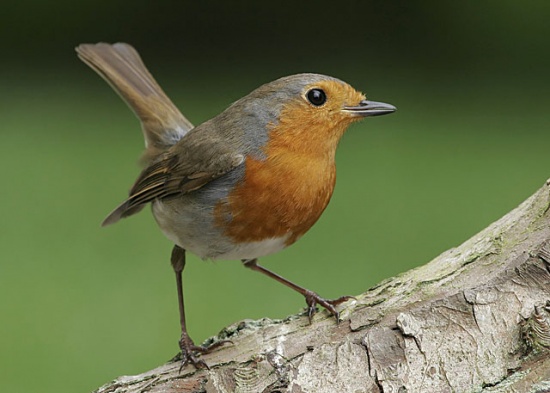m |
|||
| Line 1: | Line 1: | ||
| + | {{copyright}} | ||
[[Image:Robin.jpg|thumb|550px|right|Photo by Nigel Kiteley]] | [[Image:Robin.jpg|thumb|550px|right|Photo by Nigel Kiteley]] | ||
;[[:Category:Erithacus|Erithacus]] rubecula | ;[[:Category:Erithacus|Erithacus]] rubecula | ||
Revision as of 07:52, 1 December 2008
| This article is a copyright violation. This article violates the copyright of someone. It should be rewritten with proper references. |
- Erithacus rubecula
Identification
The European Robin is a common European songbird. It is 12.5 – 14.0 cm (5.0 – 5.5 inches) long and it is known for its pugnacious behaviour despite its small size. The distinctive red patch on the chest of both sexes led to its original name of redbreast. In the fifteenth century, when it became popular to give human names to familiar species, the bird came to be known as Robin redbreast, which was eventually shortened to robin
Distribution
It occurs all over Europe to Western Siberia, south to Algeria and on the Atlantic Ocean as far as the Azores and Madeira. In the south east, it reaches the Caucasus range.
British Robins are largely resident but a small minority, usually female, migrate to southern Europe during winter and a few of these migrate as far as Spain.
Scandinavian and Russian Robins migrate to Britain and western Europe to escape the harsher winters. These migrants can be recognised by the greyer tone of the upper parts of their bodies and duller orange breast.
Taxonomy
The European Robin (Erithacus rubecula) or, in Europe, simply Robin is a small passerine bird that was formerly classed as a member of the thrush family, but is now considered to belong to the Old World flycatchers (Muscicapidae). European Robins and similar small European species are often called chats.
European Robin is subdivided into eight subspecies, of which the central Canary Island subspecies E. rubecula superbus have been proposed for a split under the name of Tenerife Robin or maybe even superb robin; so far this split does not seem to be supported by any major authority.
Habitat
Woodland of various kinds, usually deciduous or mixed but purely coniferous in some areas. Found in lower branches of trees and in bushes and shrubs, usually feeding on the ground. Common in parks and gardens, especially in Britain, also hedgerows and road verges but avoids most open spaces.
Behaviour
The Robin is well known to British and Irish gardeners: it is relatively unafraid of humans and likes to come close when anyone is digging the soil, in order to look out for earthworms and other food freshly turned up; when the gardener stops for a break the robin might use the handle of the spade as a lookout point. Robins in continental Europe are more wary. Robins also approach large wild animals, such as wild boar and other animals which disturb the ground, to look for any food that might be brought to the surface.
Male Robins are noted for their highly aggressive territorial behaviour. They will ruthlessly attack other males that stray into their territories, and have been observed attacking other small birds without apparent provocation. Such attacks sometimes lead to fatalities, an aspect of the birds' behaviour which is inconsistent with its wholesome, gentle public image.
Robins have a fluting, warbling song in the breeding season. Robins often sing into the evening, and sometimes into the night, leading some to confuse them with Common Nightingale. Both males and females sing during the winter, when they hold separate territories, the song then sounding more plaintive than the summer version. The female Robins move a short distance from the summer nesting territory to a nearby territory that is more suitable for winter feeding. Male Robins keep the same territory throughout the year. Robins build a neat cup nest in crevices, holes or artificial sites such as discarded kettles. When juvenile birds fly from the nests they are mottled brown in colour all over and do not have a red breast. After 2 to 3 months out of the nest, the juvenile birds grow some reddish feathers under their chins and over a further 2 to 3 months this patch gradually extends to complete the adult appearance.
Bird Song
<flashmp3>Erithacus rubecula (song).mp3</flashmp3> Listen in an external program




